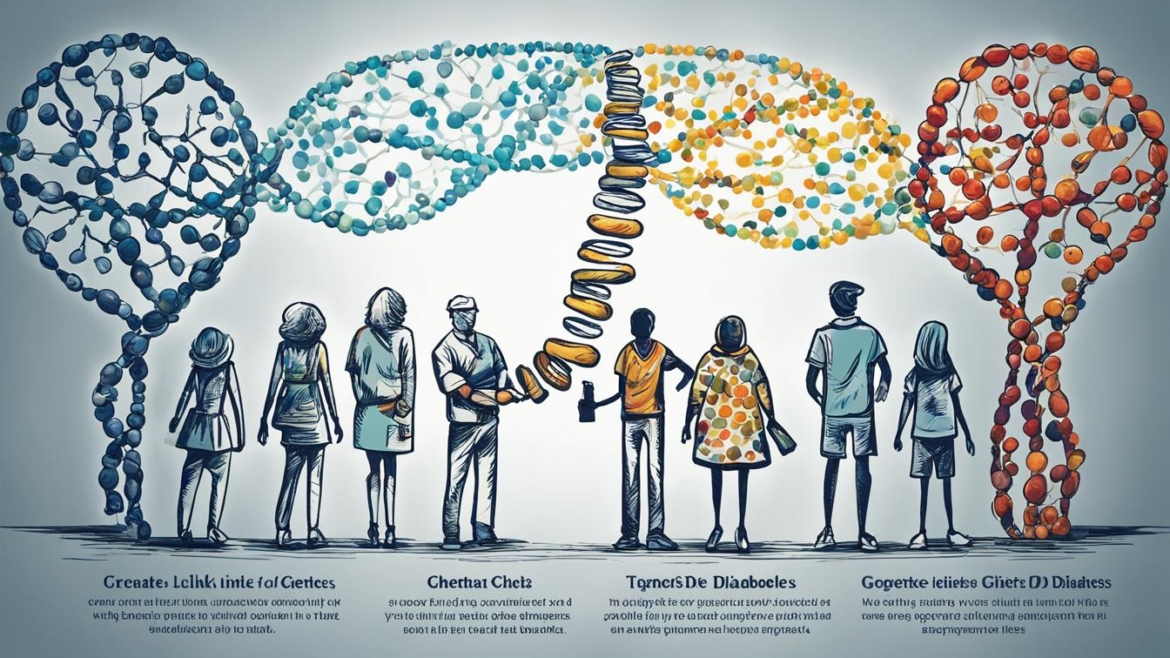Is Type 2 Diabetes Genetic? Unraveling the Truth
Diabetes is a common condition that affects millions of people worldwide. Type 2 diabetes, in particular, is a chronic illness that requires management to prevent serious health complications such as heart disease, kidney disease, and nerve damage. While there are multiple risk factors that can contribute to type 2 diabetes, including diet and lifestyle choices, the role of genetics in this disease is a topic of much debate.
In this article, we will explore the relationship between genetics and type 2 diabetes. We will examine the genetic factors that contribute to the development of this condition, the inheritance patterns of type 2 diabetes, and the role of environmental factors in interaction with genetics in increasing the risk of developing the disease.
Key Takeaways:
- Type 2 diabetes is a common chronic disease that requires management to prevent serious health complications.
- There is debate surrounding the role of genetics in the development of type 2 diabetes.
- Genetic factors can contribute to the development of type 2 diabetes.
- Type 2 diabetes can have familial inheritance patterns.
- Environmental factors can interact with genetics to increase the risk of developing type 2 diabetes.
Understanding Type 2 Diabetes
Before we delve into the genetic factors contributing to type 2 diabetes, let’s establish a basic understanding of the condition. Type 2 diabetes is a chronic metabolic disorder that affects how your body processes blood sugar or glucose. Glucose is the primary source of fuel for your body and is obtained from food. Normally, the pancreas produces insulin- a hormone that helps the body utilize glucose. However, in people with type 2 diabetes, the body becomes resistant to insulin or fails to produce enough of it, resulting in the build-up of glucose in the bloodstream. This can lead to various complications such as cardiovascular diseases, nerve damage, and kidney disorders.
The risk factors for type 2 diabetes include being overweight or obese, physical inactivity, and a diet high in refined carbohydrates and saturated fats. Age, family history, and certain ethnicities (such as African Americans, Hispanics, and Native Americans) may also increase the risk of developing the condition.
Understanding the basics of type 2 diabetes is crucial in exploring the contribution of genetics to the condition. By having a fundamental knowledge of how the disease works and its risk factors, we can better grasp the role of genetic factors and their interaction with environmental elements in causing type 2 diabetes.
Genetic Factors Contributing to Type 2 Diabetes
In this section, we will explore the role of genetic factors in the development of type 2 diabetes. Studies have revealed that genetic makeup plays a significant role in determining an individual’s risk of developing this disease. There are many genes associated with type 2 diabetes, and variations in these genes can increase one’s chances of developing the condition.
Specific genes that have been linked to an increased risk of type 2 diabetes include:
| Gene | Description |
|---|---|
| PPARG | A gene that regulates the body’s response to insulin |
| TCF7L2 | A gene that affects insulin secretion in response to glucose |
| TCF2 | A gene that regulates glucose production and insulin sensitivity in the liver |
While having these genes does not guarantee that an individual will develop type 2 diabetes, it does increase the likelihood. Other genetic factors, such as mutations and abnormalities, can also contribute to an increased risk.
It’s essential to note that genetics is not the only factor in developing type 2 diabetes. Lifestyle habits, such as a sedentary lifestyle and poor diet choices, can increase one’s risk just as much as genetics. Our knowledge of the interplay between genetics and environmental factors continues to evolve. Still, understanding the genetic components of type 2 diabetes is crucial in developing effective prevention and treatment strategies,
Unraveling the Inheritance Patterns
When it comes to type 2 diabetes, there is no doubt that genetics plays a role. But does that mean it’s hereditary? Well, the answer is not quite that simple. While type 2 diabetes can run in families, it doesn’t always. It’s important to understand the inheritance patterns to determine one’s risk.
Firstly, there’s the distinction between genetic inheritance and familial inheritance. Genetic inheritance refers to a specific gene or set of genes that are passed down from parent to child. Familial inheritance, on the other hand, refers to a shared environment or lifestyle that increases the risk of a particular condition within a family.
Several genes have been linked to to type 2 diabetes, but the condition is not caused by a single gene. Rather, it’s the combination of genetic and environmental factors that contribute to its development. If a parent has type 2 diabetes, the child is at a higher risk of developing the disease, but it’s not a guarantee.
Studies have shown that if both parents have type 2 diabetes, the child’s risk of developing the disease is around 75%. However, if only one parent has diabetes, the risk drops to around 30%. Additionally, having other family members with the condition can also increase one’s risk.
It’s not just about the number of family members with diabetes, but also their age at onset. If a close family member develops type 2 diabetes at a young age, it may suggest a stronger genetic component.
Overall, while genetics play a role in type 2 diabetes, it’s not always passed down directly from parent to child. Family history can be a strong indicator of an individual’s risk, but it’s important to also consider environmental factors such as diet and exercise habits in determining one’s likelihood of developing the condition.
The Role of Environmental Factors


As we’ve already established, genetics isn’t the only factor at play when it comes to type 2 diabetes. Lifestyle choices and environmental factors are also significant contributors to the development of the condition.
Research has shown that a poor diet, low physical activity levels, and obesity can increase the risk of type 2 diabetes. In fact, one study found that weight loss and increased physical activity reduced the risk of developing the condition by 58%.
Furthermore, research has also linked certain environmental factors, such as exposure to air pollution, to an increased risk of developing type 2 diabetes.
It’s essential to make healthy choices and engage in physical activity to mitigate your risk of developing type 2 diabetes, particularly if you have a genetic predisposition to the condition. It’s never too late to make positive lifestyle changes and break the cycle of familial predisposition!
Genetic Testing for Type 2 Diabetes
In recent years, genetic testing has become an increasingly popular way to identify an individual’s risk of developing type 2 diabetes. This test is particularly useful for those with a family history of the condition or those who have already been diagnosed with pre-diabetes.
Genetic testing can reveal whether an individual carries specific genetic variants associated with an increased risk of developing type 2 diabetes. This information can help individuals take preventive measures and make informed decisions about their health.
It’s important to note, however, that genetic testing for type 2 diabetes is not a diagnostic tool. It doesn’t reveal whether an individual will definitely develop the condition, only their increased risk.
Genetic testing for type 2 diabetes has its benefits and limitations. Some of the benefits include providing individuals with a better understanding of their risk and allowing for early intervention. Limitations include the fact that not all genetic risk factors for type 2 diabetes are known, and the test may not be covered by insurance.
In summary, genetic testing can help identify an individual’s risk of developing type 2 diabetes, but it isn’t a diagnostic tool and has both benefits and limitations.
Breaking the Cycle


Many believe that genetics inevitably determines our health fate. However, with type 2 diabetes, we can take measures to break the cycle of genetic predisposition. Even with a strong family history of this condition, lifestyle choices have a significant impact on our risk. By making informed decisions, we can prevent or delay the onset of type 2 diabetes.
Preventive Measures
Healthy Diet: A well-balanced diet low in sugar and bad fats can significantly reduce the risk of developing type 2 diabetes. Increasing fiber intake and focusing on nutrient-rich foods such as whole grains, fruits, and vegetables can improve insulin sensitivity and lower blood glucose levels. Limiting alcohol consumption also helps to decrease the risk of developing this disease.
Regular Exercise: Regular physical activity improves insulin sensitivity and glucose uptake, helping to prevent the onset of type 2 diabetes. Incorporating moderate levels of exercise, such as brisk walking, cycling, or swimming, into our daily routine can help maintain a healthy weight, lower blood sugar levels, and reduce the risk of heart disease.
Maintaining a Healthy Weight: Maintaining a healthy weight is vital in reducing our risk of developing this condition. Excess weight, particularly around the midsection, increases the risk of developing insulin resistance, a precursor to type 2 diabetes. By working towards maintaining a healthy weight through diet and exercise, we can significantly reduce our risk of developing the disease.
The Role of Genetic Testing
Genetic testing can provide valuable insight into an individual’s risk of developing type 2 diabetes. While it cannot predict with certainty whether someone will develop the condition, it can identify genetic variants associated with an elevated risk. Armed with this information, individuals can take steps to reduce their risk, such as making necessary lifestyle modifications.
Disclaimer: Genetic testing is a personal choice that should be made in consultation with a healthcare provider. While it can provide valuable information for some individuals, it may not be appropriate or necessary for everyone.
Conclusion
After exploring the connections between genetics and type 2 diabetes, we can confidently say that while genetics do play a role, they are not the sole determinant of the condition. Environmental factors, such as diet and physical activity, also contribute significantly to one’s risk of developing type 2 diabetes.
However, for those with a strong family history of the condition, it’s essential to understand that they may have a higher risk of inheriting and developing type 2 diabetes. Genetic testing can be a valuable tool in identifying this risk early on and taking necessary preventive measures.
It’s important to note that a genetic predisposition does not guarantee the development of type 2 diabetes. With proper lifestyle choices and preventive measures, we can mitigate the risk of developing the condition, even in those with a family history of the disease.
We hope that this article has shed light on the complex interplay between genetics and type 2 diabetes and the steps we can take to break the cycle of inherited type 2 diabetes.
Thank you for reading, and please contact us with any questions or concerns.
FAQ
Is type 2 diabetes genetic?
Yes, there is a genetic component to type 2 diabetes. While lifestyle factors play a role, genetics can also increase the risk of developing this condition.
What are the genetic factors contributing to type 2 diabetes?
Several genes have been identified that can contribute to the development of type 2 diabetes. Variations in these genes can increase the risk of developing the condition.
Can type 2 diabetes be passed down through generations?
Yes, type 2 diabetes can have a hereditary component. Having a family history of the condition increases the risk of developing it.
How do environmental factors impact the risk of type 2 diabetes?
Environmental factors, such as diet and physical activity, can interact with genetic predisposition to increase the risk of developing type 2 diabetes.
Is genetic testing available for type 2 diabetes?
Yes, genetic testing can help identify an individual’s risk of developing type 2 diabetes. However, it is important to note that genetic testing is not definitive and should be interpreted in the context of other risk factors.
Can the cycle of genetic predisposition to type 2 diabetes be broken?
While genetics play a role in type 2 diabetes, lifestyle choices and preventive measures can help reduce the risk of developing the condition, even in individuals with a strong family history.
What is the role of family history in type 2 diabetes?
Family history is an important risk factor for type 2 diabetes. Having a close relative with the condition increases the likelihood of developing it.
In conclusion, is type 2 diabetes solely determined by genetics?
No, type 2 diabetes is not solely determined by genetics. Both genetic and environmental factors contribute to its development. With proper lifestyle choices and preventive measures, the risk of developing type 2 diabetes can be mitigated, even in individuals with a genetic predisposition.

